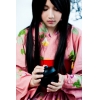|
 Kimono is
the word that sounds quite awkward for the person who knows nothing of Japan
an its traditions. Some people believe that kimono is the silky gown customary
for the tea ceremony so typical for Oriental countries while the others
consider that this is the attribute for traditional Oriental martial arts. The
beliefs are not so authentic, people just guess and are right to some extent.
Actually kimono is the attire, the garment which is not typical to geisha or a
karateka only. Kimono is the traditional clothes of the Japanese people and it
is available in variants, as different as occasions come to wear it. Kimono is
the word that sounds quite awkward for the person who knows nothing of Japan
an its traditions. Some people believe that kimono is the silky gown customary
for the tea ceremony so typical for Oriental countries while the others
consider that this is the attribute for traditional Oriental martial arts. The
beliefs are not so authentic, people just guess and are right to some extent.
Actually kimono is the attire, the garment which is not typical to geisha or a
karateka only. Kimono is the traditional clothes of the Japanese people and it
is available in variants, as different as occasions come to wear it.
The
Japanese restored the tradition to wear kimono for everyday life not so long,
namely in the end of the XX century. This garment was preferred for various events
and functions Asia is famous for and kimono is
different from occasion to occasion. Special kinds of kimono are designed for each
event for women and for men who are to choose them in accordance to age and
social status. Otherwise the traditions are broken which is equal to ignorance
of culture.
Kimono is
liked by both men and women. The models of kimono for women come in more styles
and prints; they have longer sleeves and the band called obi is far wider and
is tied on the back as a bow. Kimono for men is more restricted in color range
and obi is tied at a lower line, on the back or at the side. Moreover, kimono
comes as for ceremonies and as home wear. Women’s kimono is more complicated in
tailoring though it is not for beauty but as the homage to the ancient culture.
Married women
wear Kurotomesode
kimono for formal functions to be the strictest kimono of black color with the
pattern on the lower part. Irotomesode is the kimono that is slightly less
formal than kurotomesode,
and is also worn by married women. They come in other colors, but the customary
condition is that they should be of a single color, with the pattern below the
waistline.
A Furisode (swinging
sleeves) is a style of kimono known for its long sleeves, mainly for the young
women, of vivid color with pattern all over the garment. The swinging sleeves
perfectly go with the image of a young girl.
All
Japanese women are allowed to wear Homungi with its
asymmetrical pattern which goes without a break across the side seams to the
back hem. The Homongi kimono is made from bolts of silk sewn up into the
finished length, then painted, taken apart, dyed, and then sewed again. The
Tsukesage kimono can be worn by women of any marital status for any occasion.
The pattern on the Tsukesage kimono is dyed from the hemline in the front and
back which goes to the top of the shoulders. The print on the sleeves also
travels upward. Homungi or the clothes for visiting has the expressive pattern in
the upper and lower parts of the clothes and thus it is far more favored by
young women. The Tsukesage
kimono is far more moderate with the single-color fabric and the print under
the waistline.
The Iromudzi
kimono is designed for the tea ceremony especially for single girls. The fact
that the tea ceremony is informal occasion does not matter in the style of the
Iromudzi kimono which is very strict, of single color with the laconic weaved
pattern.
In contrast
to the single-color Iromudzi kimono there is another kimono which is called the
Komon kimono, the beautiful pattern. This kimono has a fine repeating pattern
over the surface which makes it less formal to use for every day wear.
And, finally,
the least strict kind is the Yukata kimono which symbolizes the informal event
to allow the versatile patterns. The fabric for the Yukata can be varied.
Traditionally
kimono is the silky wear but it is often sewed with some cotton or flax threads
which is typical for the informal occasions, like a summer holiday, festival or
out to the restaurant.
It is not a
secret that the Japanese fashion covered the whole world with its silky threads
and the concern in the national clothes of this country is still increasing
with the time.
Traditionally
kimono is quite the complicated piece of clothing which is formed from several
parts which are gathered together on the female body by the specialist
qualified to do that. Today the Japanese make the way to wear kimonos
simplified for themselves and for the people who are long for the Japanese
wear. Currently kimonos are manufactured as less intricated by design and there
are models that resemble customary gowns with the note of Japanese charm. It is
too simple to put them on though unlike other gowns these models have the chic
of the Oriental culture and the sensible scent of authentic Japan.
|